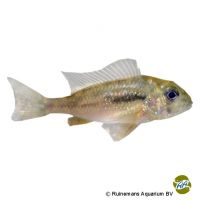Eartheater (Gymnogeophagus caaguazuensis)
| Eartheater Gymnogeophagus caaguazuensis | |
|---|---|
| Name | Eartheater |
| Name Lat. | Gymnogeophagus caaguazuensis |
| Family | Cichlids |
| Family lat. | Cichlidae |
| Order | Cichlids |
| Order lat. | Cichliformes |
| Origin | South America |
| Habitat | Rivers, oxbow lakes |
| Diet | Omnivore |
| pH | 6.5-7.5 |
| Behavior | Peaceful |
| Keeping | Pair |
| Care Level | Moderate |
| Reproduction | Mouthbrooder |
| Breeding | Moderately difficult |
| Life Span | 5-8 years |
| Protection | No |
| Metric Units | |
| Size | 8-12 cm |
| Temperature | 18-24 °C |
| Hardness | 5-15 °dH |
| Aquarium | 200 l |
| US Units | |
| Size | 3.1"-4.7" |
| Temperature | 64-75 °F |
| Hardness | 89-267 ppm |
| Aquarium | 50 gal |
Distribution and habitat
Yellow-bellied Prachterdfressers are found in the lower Rio Paraguay watershed in Paraguay. They live in slow-flowing or stagnant sections of rivers, bays and lakeshore zones with muddy, sandy bottoms.
Maintenance
The aquarium should have a robust border planting, with some round river stones and roots as hiding places, and plenty of free sandy areas suitable for burrowing. A soft, deep substrate covered with some foliage (e.g. sea almond tree, oak) and subdued light (floating plants) is ideal.
No ammonia, ammonium and nitrite should be detectable in the water, and the nitrate value should not exceed 100 mg/l. To ensure water quality and oxygen content, a filter and heater adapted to the size of the aquarium is required, as well as lighting for the proper day-night rhythm of the animals.
Diet
The food supply consists of live, frozen and dry food. For a balanced diet, feed once daily with a high-quality sinking dry food (granules, pellets, tablets) as well as tubifex, artemia, mysis, mosquito larvae or shrimp (live or frozen). In addition, they need regular vegetable food, such as blanched leafy and wild vegetables, algae leaves or dry food with vegetable ingredients (e.g. spirulina). It is recommended to feed small portions several times a day. Only feed as much as will be eaten within a few minutes. A regular and varied diet promotes health.
Behaviour and compatibility
They should be kept in pairs. Males are territorial within the species, so keeping several pairs is only recommended in a larger and richly structured tank. They are relatively compatible with other fish and can be kept together with smaller South American cichlids and catfishes (e.g. Rineloricaria)
Basically, only compatible fish species with similar demands on water condition and water temperature should be socialized.
Sex dimorphism
The slightly larger male has a longer extended dorsal and anal fin, a clearly developed frontal hump and a pointed genital papilla, which is round in the female. In juveniles it is difficult to determine the sex.
Reproduction and breeding
They are larvophilic mouth brooders. The eggs are laid by the female on a flat, well-cleaned stone or similar and fertilized by the male. The larvae hatch after about 2 days and are immediately taken up by the female into the spacious gullet (pharynx) for mouthbrooding. After 7-14 days, the fry are released from the mouth. They are guarded by both parents for a few more days before brood care ends
Fry must be fed several times a day with special rearing food (Artemia nauplii). Breeding is hardly possible in community tanks, as the fry are easy prey.
Important
They are the smallest known species of terrestrial eaters. Observation shows that at higher water temperatures their aggressiveness increases
When searching for food, they rummage through the bottom. According to this species-typical behavior they are also called scavengers. Plants are not eaten, but should be placed in pots and secured with stones to prevent them from digging out. The foliage (sea almond tree, oak etc.) enriches the water with humic substances and lowers the pH value in a natural way.
The well-being of the fish should be checked regularly. The temperature should be checked daily, the pH, hardness and nitrate value at least every 14 days. Regular partial water changes are recommended, even if the contaminant level has not yet reached the upper limit. Sudden changes in water quality should be avoided. Newly introduced fish must be accustomed slowly to the water in the aquarium.
Further literature can be found in your pet store.
References
Text: petdata; Image: Franz Lowak
Source: BMELV (1998): Tierschutzgutachten - Haltung von Zierfischen (Süßwasser); ENGELMANN (2005): Zootierhaltung - Tiere in menschlicher Obhut: Fische, Verlag Harri Deutsch
- Gemäß § 21 Abs. 5 Tierschutzgesetz idgF
